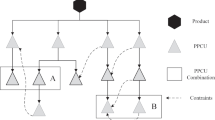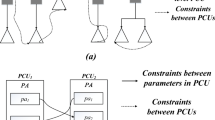Abstract
The application of product configuration model is an effective way to improve product design and manufacturing efficiency. The traditional product configuration model has a single configuration result, and the configuration model is difficult to be expanded. In order to solve the existing problem, a scalable product configuration model is established based on polychromatic sets theory and corresponding algorithm is proposed. Firstly, product modules are clustered according to function types to establish function block, which is the solving unit of product configuration model. At the same time, multilayer polychromatic set contour-comprising matrices are respectively established from the point of view of needs, product, performance and module. According to actual demand of product configuration, the unified color reasoning algorithm is proposed. And scalable product configuration model and algorithm are proposed based on relative works. Then, the scalability of proposed model is studied from the point of view of needs change and modules change. Finally, the configuration of a special vehicle is introduced to verify the presented model and algorithm, and the results confirmed the effectiveness and rationality of the method.










Similar content being viewed by others
References
Ostrosi, E., Fougeres, A.J., Femey, M.: Fuzzy agents for product configuration in collaborative and distributed design process. Appl. Soft Comput. 12(8), 2091–2105 (2012)
Yang, D., Dong, M.: A hybrid approach for modeling and solving product configuration problems. Concurr. Eng. Res. Appl. 20(1), 31–42 (2012)
Teseng, H.E., Chang, C.C., Chang, S.H.: Applying case-based reasoning for product configuration in mass customization environments. Expert Syst. Appl. 29(4), 913–925 (2005)
Zhaoxun, C., Liya, W.: Adaptable product configuration system based on neural network. Int. J. Prod. Res. 47(18), 5037–5066 (2009)
Guo, C., Qiu, L., et al.: Optimization and application for complex product configuration model based on coupling intensity design structure matrix. Comput. Integr. Manuf. Syst. 18(4), 673–683 (2012)
Pavlov, V.V.: Polychromatic Sets and Graphs for CALS. Stankin Press, Moscow (2002)
Tang, F., Li, Z.: A new approach to conceptual design of mechanical products using polychromatic sets. J. Comput. Aided Des. Comput. Graph. 15(2), 150–155 (2003)
Jiang, L., Xi, X., Li, M., Li, Z.: Research on conceptual design of jig and fixture based on polychromatic sets. China Mech. Eng. 17(8), 832–836 (2006)
Li, Z., Zhao, L., Ling, Y., et al.: Study of polychromatic sets and its application in the concept design for mechanical products. J. Comput. Aided Des. Comput. Graph. 14(7), 688–692 (2002)
Ji, P., Lau, F., Jiang, L., et al.: Computer-aided generation of fixture configuration design using polychromatic sets. Int. J. Comput. Appl. Technol. 28(4), 289–294 (2007)
Gao, X., Li, Z., Li, L.: A process model for concurrent design in manufacturing enterprise information systems. Enterp. Inf. Syst. 2(1), 33–46 (2008)
Qiao, H., Mo, R., Yang, H., Xiang, Y.: A product modular planning method considering custom needs. J. Northwest. Polytech. Univ. 32(2), 256–261 (2014)
Wang, S., Li, Y., Chen, F., et al.: Process planning and resource allocation in aircraft connection assembly based on polychromatic sets. Comput. Integr. Manuf. Syst. 19(2), 411–420 (2013)
Gao, X., Xu, L., Wang, X., Li, Y., et al.: Workflow process modelling and resource allocation based on polychromatic sets theory. Enterp. Inf. Syst. 7(2), 198–226 (2013)
Acknowledgements
The project is supported by National Natural Science Foundation of China (Grant No. 51705392) and Xi’an Technological University President Foundation (Grant No. XAGDXJJ16004).
Author information
Authors and Affiliations
Corresponding author
Rights and permissions
About this article
Cite this article
Qiao, H., Feng, F., Qi, J. et al. A scalable product configuration model and algorithm. Cluster Comput 22 (Suppl 3), 6405–6415 (2019). https://doi.org/10.1007/s10586-018-2146-7
Received:
Revised:
Accepted:
Published:
Issue Date:
DOI: https://doi.org/10.1007/s10586-018-2146-7




